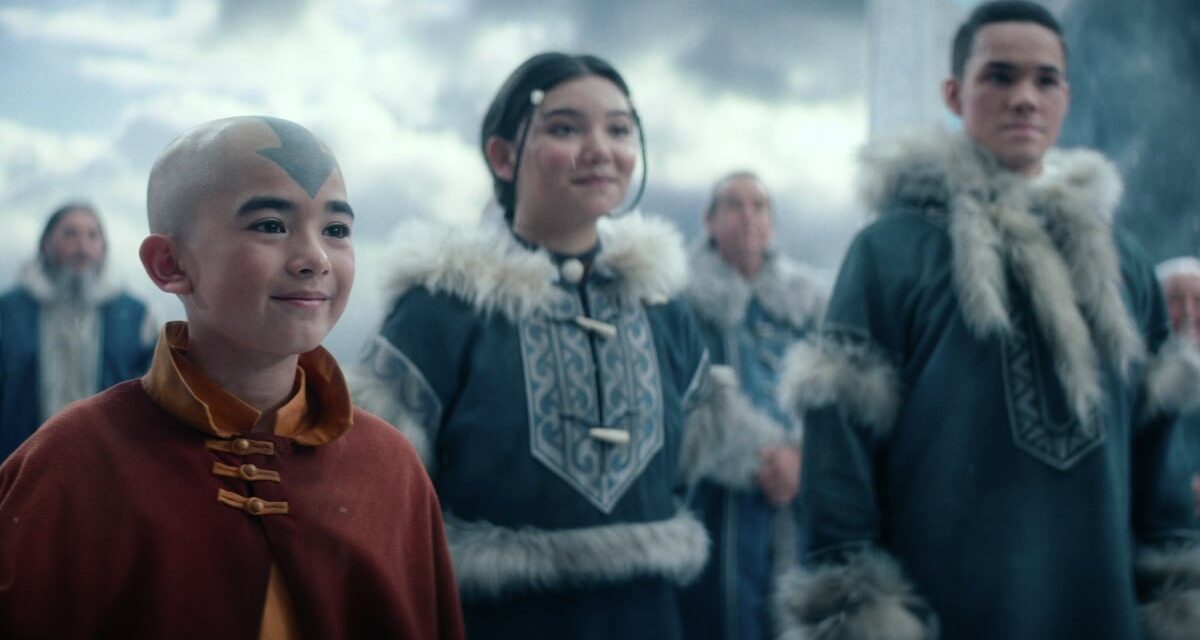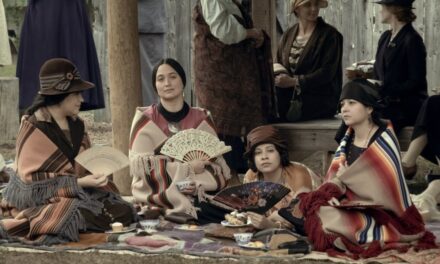The bar on a live-action Avatar: The Last Airbender adaptation is at once insurmountably high, and somewhere six feet under.
On the one hand, it’s almost impossible to reach the standards of the much-beloved original animated series. On the other, it should be easy to avoid the mistakes of M. Night Shyamalan’s widely panned 2010 film version, an adaptation so bad that fans have agreed it doesn’t exist. (“There is no movie in Ba Sing Se” is a common fandom refrain.)
With miles’ worth of quality separating these two goal posts, it’s only fitting that Netflix’s live-action take on Avatar: The Last Airbender falls somewhere in the middle. The new show is nowhere near the failure of the film, nor as spectacular as the series — but it’s not of uniform quality, either. As if torn between its predecessors, Avatar: The Last Airbender alternates between high highs and low lows, both of which stem from adaptation choices that range from fresh and exciting to dull and bewildering.
What’s Avatar: The Last Airbender about?
Appa is one of “Avatar: The Last Airbender”s highlights.
Credit: Courtesy of Netflix
In the vein of Netflix series like Scott Pilgrim Takes Off or Shadow and Bone, Avatar: The Last Airbender is less a straightforward adaptation than it is a remix of its source material. However, the main conceit of the story remains the same, with beats that will be familiar to everyone who’s ever watched the original series, or even just heard snippets of its unforgettable opening. Water, earth, fire, air… and it’s stuck in our heads again.
Avatar: The Last Airbender reworks that same introduction through an opening credits sequence of its own, one where the words have been changed just enough in what feels like a “you can copy my homework, but change it a little so they don’t realize” type of situation. As the show tells us, in a world where benders can control water, earth, fire, or air, only the Avatar can master every element and bring balance to the four nations. But after the Fire Nation began a brutal conquest — including wiping out the Air Nomads in the hopes of killing the Avatar — the Avatar vanished entirely.
A hundred years later, waterbender Katara (Kiawentiio) and her brother Sokka (Ian Ousley) discover the Avatar, an airbender named Aang (Gordon Cormier), preserved in an iceberg. He’ll need Katara and Sokka’s help on his quest to save the world, but their journey won’t be easy. The disgraced Fire Nation Prince Zuko (Dallas Liu) and his uncle Iroh (Paul Sun-Hyung Lee) are hot on their trail.
Avatar: The Last Airbender reimagines Aang’s story — with varying degrees of success.
Kiawentiio, Gordon Cormier, and Ian Ousley in “Avatar: The Last Airbender.”
Credit: Robert Falconer/Netflix
This season follows the arc of the animated show’s first season, also known as “Book 1: Water.” Since it clocks in at eight hour-long episodes, which naturally have a different structure from the original’s 22-minute-long episodes, Avatar: The Last Airbender begins making changes right away. Entire episodes from the original are cut or smashed together in the show’s Book 1 speedrun, while other story elements are expanded upon in new — and sometimes intriguing — ways.
Take the show’s treatment of the Fire Nation. Avatar: The Last Airbender introduces Fire Lord Ozai (Daniel Dae Kim) and Princess Azula (Elizabeth Yu) much earlier than its animated counterpart, fleshing out some Fire Nation palace intrigue. (I get it: If you get Daniel Dae Kim, you use him as much as you can.) While they can sometimes feel shoehorned in in the context of Aang and Zuko’s respective stories, these new scenes do provide a fascinating perspective on the show’s villains right off the bat, priming us for their further involvement in a potential second and third season.
The series also fleshes out events that are referenced in the original show but never seen, such as the Air Nomad genocide. That additive approach proves smart: Why try to match a masterpiece beat for beat when you can build on it in other ways? Notably, many of the most successful additions are more violent than scenes you’d expect from a cartoon geared toward younger viewers, with showrunner Albert Kim taking advantage of the streaming format to perhaps lure in audiences with a taste for darker, grittier fantasy. (In an interview with IGN, Kim did discuss wanting to appeal to Game of Thrones fans.)
Netflix’s ‘Avatar: The Last Airbender’ does right by a fan favourite: the cabbage merchant
The sorun with trying to appeal to Game of Thrones fans — or more broadly, those with high fantasy tastes — is that Avatar: The Last Airbender often jumps to the conclusion that more lore will make for a more interesting adaptation. Want to complicate a storyline viewers already know? Why not throw some long-winded exposition and a clumsy MacGuffin at it? That should do the trick.
These issues stem not just from a desire to build a Thrones-style fantasy phenomenon, but also from the sheer amount of source material crammed into each episode. Full storylines from Book 1 are stacked one atop the other for maximum efficiency, at one point creating an unholy “Jet”-“King of Omashu”-“Northern Air Temple” sandwich. These make for interesting combinations at best, unwieldy slogs at worst.
Don’t even get me started on the moments when Avatar: The Last Airbender brings elements from the original’s second season into the fray. We can barely cover three quarters of Book 1 in this season — bringing Book 2 into it only jams up momentum! It’s the TV equivalent of a used car salesman slapping the show’s hood and saying, “This baby can fit so much lore in it,” when all we really want is to spend time with our favorite characters.
Avatar: The Last Airbender loses some of its characters — and some of its magic — in the transition to live action.
Paul Sun-Hyung Lee and Dallas Liu in “Avatar: The Last Airbender.”
Credit: Courtesy of Netflix
Speaking of our favorite characters, how do they fare in their (second) jump from animation to live action? The answer is a mixed bag. Zuko is thankfully as angsty and conflicted ever, with Liu bringing the perfect amount of tortured intensity — and a smidge of brooding drama king energy — to the role. His performance lays the groundwork for one of Avatar: The Last Airbender‘s most iconic character arcs, to the point that I do want to see more of his take on the character.
Sokka is another success story. There’s been a lot of online outrage about comments that the show is toning down his original sexism, but the way Avatar: The Last Airbender handles Sokka’s budding crush on and respect for Suki (Maria Zhang) proves to be a sweet new take on their relationship. (Given the show’s underwhelming treatment of the Northern Water Tribe’s sexism later on, it’s likely we dodged a bullet.) Ousley nails Sokka’s sense of humor, but he also does well in moments of dramatic depth, like when the series explores his complicated relationship with his father and his self-imposed role as a warrior.
Aang and Katara are not so fortunate in this live-action outing, their edges and emotions sanded down to repetitive platitudes. There’s little sense of childish fun in Aang: Cormier is stuck delivering scene after scene of dialogue about the burden of his responsibilities or exposition about the inner workings of the spirit world. Without any kind of lightness or joy, there’s nothing to measure Aang’s new worries against.
Meanwhile, Katara is forced into a near-permanent state of hope and wonder. Avatar: The Last Airbender simply refuses to let her be anything greater than lightly upset — even when she’s discussing the death of her mother. Where is her anger, her frustration? Where is the waterbender who yelled, “You can’t knock me down” in the face of her detractors?
At least Avatar: The Last Airbender is a visual feast — to a certain extent. Iconic locations from the cartoon, like Omashu and the Northern Water Tribe, come to detailed life. Yet there are moments when characters look as if they’re standing in front of a flat, beautiful background instead of inhabiting a location with any real depth.
Bending also proves to be a double-edged sword here. In some cases, such as with firebending and airbending, these displays of power are fluid and captivating. Waterbending and especially earthbending are somewhat slower and clunkier. The action sequences can feel uneven as a result, to the point that one of Avatar: The Last Airbender‘s most enjoyable and inventive fights is one in which Zuko and Aang rarely bend.
Many of these qualms simply stem from the switch in medium from animation to live action: Fight scenes involving bending are less limited when animated, while characters are able to be even more expressive than in reality. So knowing the allowances of animation, why endeavor to make that jump at all in the first place? Or in Netflix’s case, after its anime-to-live-action shows like Cowboy Bebop and One Piece, why continue to make these attempts at all? How much of a franchise can you really build when fans will inevitably just return to the animated original?
Better than Cowboy Bebop, less enjoyable than One Piece, Avatar: The Last Airbender falls smack dab in the middle of Netflix’s own live-action adaptations, just as it does with its own predecessors. In a strange way, its own quality reflects one of Avatar‘s core tenets: balance. Neither awful nor amazing, it is simply… fine.





